Happy Trails: Benefits of Trail Running & What to Know Before You Go
Now that my big fall races are over, I’ve been spicing up my workout and training schedule with some variety. In addition to my traditional road running, I’m trying some new things. You already know I started a 12-week boot camp last week (which has included tons of sprints, speed work and yes, soreness!). Yesterday, I started trail running.
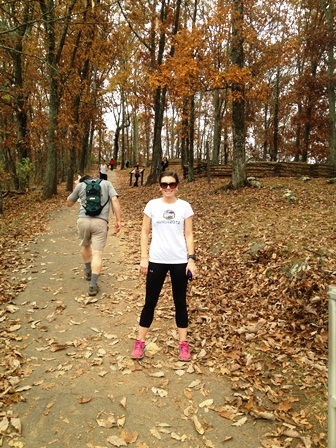
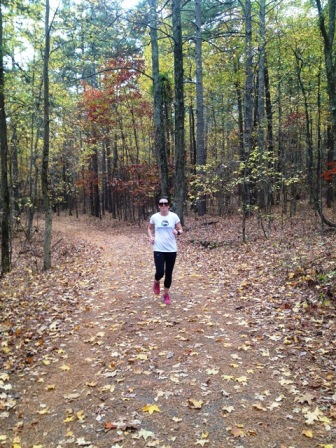
In my quest to get stronger and tougher and to change things up, Mr. rUnladylike and I drove about 35 minutes north of Atlanta to go trail running at Kennesaw Mountain (summit elevation = 1,808 feet). There’s a 5.7-mile loop that takes you up to the summit and then back down around the mountain, with lots of tough inclines, rolling hills and some nice downhill sections. The first 4 miles are fairly rocky, while the last 1.7 are on a wooded path.
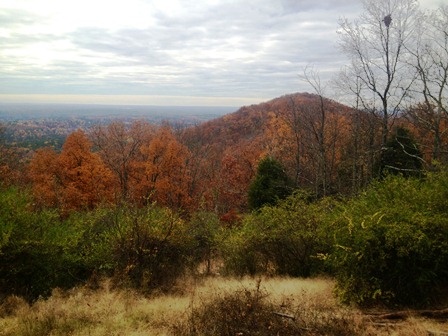
As we were running – and in the hours after our trail run – I kept asking myself why on Earth I don’t do more trail running. Our run was too good not to repeat and share.
As you find yourself looking at your own running plan and workout schedule, consider including some trail runs into your normal routine. I’m going to try to dedicate more Sundays to trail running during the next few months. Below are the benefits I found from trail running, as well as 7 tips to know before you go.
Benefits of Trail Running
- It helps you remember why you enjoy running. I think the best thing about trail running is that it helps us remember how enjoyable and fun running can be. It gives us a chance to enjoy the beauty of our surroundings. To look around instead of just at our Garmins. To breathe the fresh air and stop worrying about hitting that mile split or keeping up with our running partner. There’s no pressure in casual trail running. Fast and slow runners can run together given the more challenging terrain and slower paces trail running demands. It’s a great way to break up a training week and eliminate the pressure you might put on yourself – while still getting a solid workout. Some views from my run …
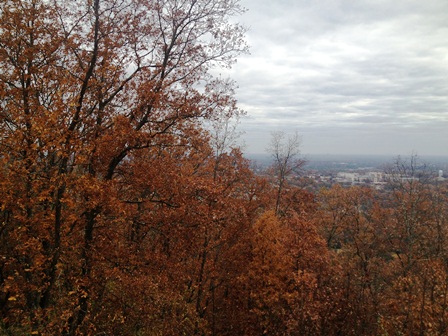

- It can give your feet and legs a break from the asphalt. After the constant pounding on roads, sidewalks and streets, trail running can give your body a nice little break by offering softer surfaces and different terrain. From dirt and gravel paths, to narrow lanes of grass and carpets of pine needles and leaves, the softer surface will be a welcome treat for your feet and legs.
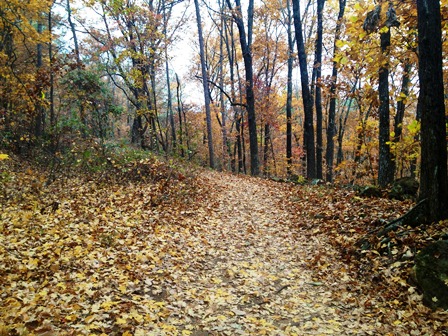
- It can help you strengthen muscles you don’t always use. Trail running will definitely awaken some muscles you may not typically engage while jogging on your neighborhood sidewalks. For instance, you use your feet and ankles in different ways, while your quads, hamstrings and calves work harder on steeper inclines and downhills. You might notice that your ankles are even sore after your first trail run with all the extra footwork you may do around rocks, branches, etc.
- It can provide a great hill workout. If you can find a trail that’s part of a mountain (no matter how high in elevation), you can really challenge yourself with the inclines. These trails will likely offer steeper inclines than you’ll find in your neighborhood or on nearby hilly streets. You can really get your heart rate up! I know I did!
My 7 Tips to Know Before You Go Trail Running
- Wear the right shoes. Because trails can present more treacherous terrain than you may be used to on your normal running routes (e.g. rocks, branches, tree roots hidden by leaves, steep dirt downhills, etc.), it’s important to have a good pair of running shoes with good traction and tread. You don’t have to run out to the store and buy a pair of trail shoes to try out trail running, but you do want to make sure that your shoes have strong support and good tread to avoid slipping and sliding. If you decide you really enjoy trail running, then it’s time to invest in a good pair of trail shoes. I’m a fan of Brooks and my husband loves his Patagonia trail shoes.
- Bring hydration (and fuel). Trail running can be more grueling than a normal run on streets and roads. Your heart rate is likely to kick up if you’re on a trail with lots of hills, and it will very likely take you a third as long to run the same distance you can on the road. Since running just 5 miles could take you more than an hour on a challenging trail course, it’s important to consider taking the proper hydration and fuel with you since you’ll likely be running more than 1 hour. Nathan hand-held water bottles with a pouch and Camelbaks are great options.
- Beware of leaves. During the fall, trails are often covered in leaves. This can disguise rocks and large protruding roots as flat surfaces. Make sure you are very diligent about your footing and look carefully in front of you. Leaves can also make the terrain slicker, making it easier to slip on a slight decline, rock or other natural obstacle. Yesterday, the leaves sent Mr. rUnladylike down, sliding on the dirt and cutting up his knee. Be careful!
- Avoid trail running when it’s wet. Water makes the leaves (see #3), rocks, branches, roots, etc. slick and easier to slip on. Downhill sections can be very challenging when it’s wet, and even the best trail shoes can slide down these declines. Wait until things dry out before going for a trail run, especially if you’re new at it like me.
- Take proper safety precautions. Not to scare you, but trail running can present even more safety concerns than normal road running because you’re typically away from crowds and traffic and are more likely to encounter more solitude and be further away from help should something happen. First, don’t do any trail running alone. It’s always better to have a partner in case you get hurt and when you’re running in a place with few people around. Be sure to wear a Road ID or carry your personal information with you. Should you get hurt, someone will know who you are and who to call in case of an emergency. Bring your cell phone with you so that if you fall or are injured, you can contact someone immediately for help. It’s also not a bad idea to bring a whistle with you in case you and your running partner fall or get lost and someone needs to come looking for you. I know I’m presenting the worst case scenario here that will probably never happen, but you want to be prepared in case it ever does.
- Be courteous to fellow walkers, hikers and trail runners. If you’re running on more popular trails that get lots of visitors, you’ll likely find yourself stuck behind families and walkers in narrow spaces. Be patient. You may have to slow down, jog in place or stop and walk momentarily before you can get around them. Don’t get annoyed that they’re slowing you down. They are enjoying the beauty and scenery just like you, but in a different way. Be polite, courteous and don’t forget to thank people who move over so you can run by.
- Be prepared for a slower pace. Last but not least, do NOT expect to run the pace you run on the roads. You are likely to be 1 to 5 minutes slower depending on the incline and terrain. On Sunday, I was an average of 4 minutes slower per mile than my normal pace due to steep inclines and declines, as well as stopping to walk a few times and waiting to pass others. Casual trail running isn’t a race. There’s no medal waiting for you back at your car. Enjoy yourself. Just run.
Do you ever go trail running? If so, what do you like best about it? What tips would you offer others interested in trail running?



Comments
I love the trails, they always clear my mind.. so quiet and peaceful. Your run looked amazing. I have always wanted to trail run Georgia… on my fitness bucket list.
Come to Georgia, Lisa! I would LOVE to go for a trail run with you 🙂
I also love trail running and like to go to that same park from time to time. Check out the Kolb Farm loop as another option that has less steep hills than the one it looks like you did over the weekend. Bonus is it takes you by some interesting historical artifacts from civil war. Also – deer! 🙂
Oooh! I’ll have to try the Kolb Farm loop. We did the Pigeon Hill loop from the visitor’s center on Sunday. Let’s plan a trail run together one of these days. 🙂
Name the date, friend! 🙂
“It helps you remember why you enjoy running.” So much truth to this statement. Every time I am able to get out for a trail run, it resparks something in me which helps push me further and faster. I could spend entire days trail running…there’s really no other outdoor experience like it!
Where I work I’m able to do road running and a little trail running. I make my course go both on and off the trails to keep it interesting. But I usually carry a knife with me in case.
Trail runs are my favorite! It’s the scenery and the constant change of terrain that keeps me entranced in everything of those runs. Most of my races have been trail runs.
A few times, the sunset has crept up on me and I didn’t have my headlamp with me so I need to be conscious of the time on those long runs and I need to take proper hydration with me. Otherwise, I’m enjoying those long afternoon runs through the trails.
Ricardo, Sounds like you may need to give me some tips with all your experience!!! Would love to hear any and all advice you may have 🙂
[…] Want to give trail running a shot and don’t know where to start? Check out Jesica’s post on the basics of Trail Running. […]
I love trail running!